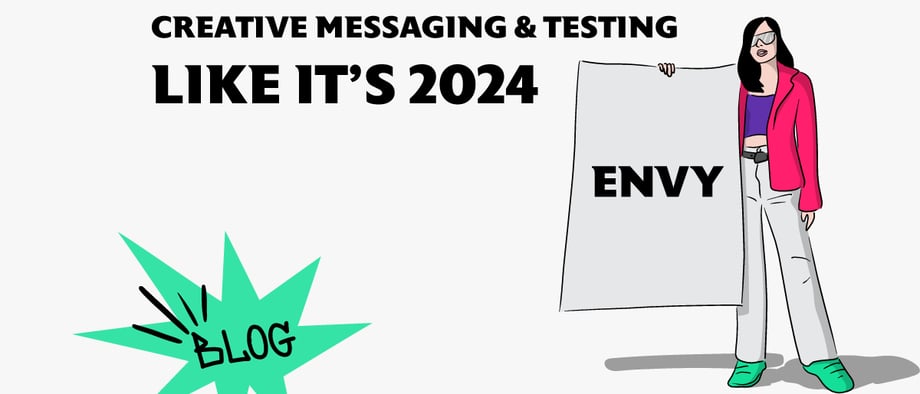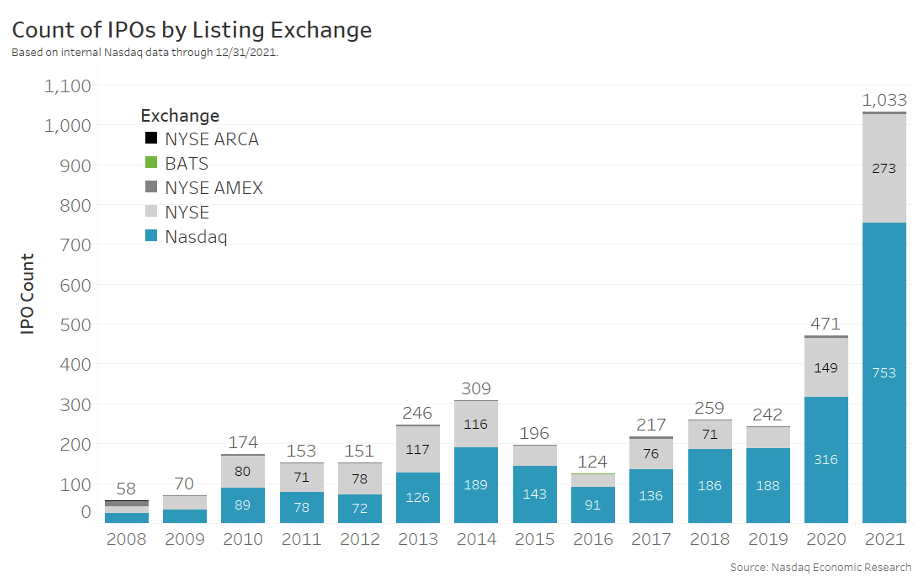
Creative Messaging & Testing Like It’s 2024
If your brand messaging process is taking you ~6 months from ideation to rollout across all your marketing and sales assets, stop right now. Your market will have changed by the time you get out of the door. There’s a much quicker and more effective way to do this. Read on.
The good ol’ days for B2B tech (and tech marketing)
Oh boy, do you remember 2021? Everyone was scaling, everyone wanted to grow, start-ups and unicorns were knocking at our doors and windows en masse to get their messages out there and drive new customers in - all with deadlines set up for yesterday. Quite the show, right? I mean, just look at this chart!
 Source: Nasdaq Economic Research
Source: Nasdaq Economic Research
Don’t get us wrong, we weren’t complaining at all - until it all was over quicker than anyone anticipated. Barely six months in to 2022 and all the companies who wanted to scale were suddenly struggling to survive. The messages they were sending out? No longer relevant. The moral of the story? Messaging is all about timing and time is of the essence.
So if your brand or product messaging process is longer than a few short weeks, you’re in for (relevance) trouble.
What’s Killing Your Messaging Process
This is where the real fun starts.
Most B2B tech marketers hate working on their company’s messaging and branding. The fear that the outcome will be generic and downright boring is a real one, and so it should be. I mean take a look at these examples of company descriptions…

Bloody hell. I’ve read these all at least ten times before and I still have no idea what they’re saying. Buzzwords, useless jargon, and cliches are killing your messaging and marketing campaigns. You know what I’m talking about - “seamless”, “all encompassing”, “ML/IA”, “end-to-end”... you get my drift.
So we know we don't want to sound the same as our competitors, but what about looking like them? Well, take a look at these beauties…
.jpg?width=4000&height=2250&name=8%20rules%20to%20rock%20your%20campaigns%20in%202024%20SEO%20is%20your%20staple%20(1).jpg)
I like to call this the blue screen of death.
I bet if you remove the logos and the colorful CTAs, you won't be able to tell them apart. The thing is, if you’re not memorable, nobody is gonna want to buy your product.
1. Your grandma's committee
.jpg?width=4000&height=2250&name=8%20rules%20to%20rock%20your%20campaigns%20in%202024%20SEO%20is%20your%20staple%20(2).jpg)
C’mon, you know what I mean. Not your actual grandma. I love your grandma. Let me explain.
You enter a messaging process with approximately 3-4 relevant individuals involved, and all seems fine. Everyone is content and satisfied. However, things take a turn when the CTO joins the discussion and offers her input. Subsequently, the VC catches wind of the discussion and chimes in with his viewpoint.
Oh, and we mustn't forget to mention the CEO's sister, who has recently completed her Master's in Marketing & Communications and feels compelled to share her thoughts on the matter. Before you realize it, 10 people have assessed and provided input on your messaging. If there's one thing you are lacking, it's time for 10 people to evaluate and provide feedback on your messaging strategy.
2. Time is of the essence
The second thing killing your messaging is time for validation. The validation process for messaging in an organization is crucial, but the time it takes can be a major obstacle. Many organizations face this challenge, and the process typically unfolds as follows:
- Internal Review and Refinement: Your messaging undergoes an internal review where stakeholders provide feedback. Afterward, you refine the messaging to address any issues or improve its effectiveness.
- Focus Groups or Surveys: To gauge audience reactions, you might test the messaging with focus groups or surveys, gathering valuable insights to enhance its resonance.
- Management Alignment: The messaging then needs alignment with management's vision. This step ensures that the messaging aligns with company goals and values.
- Asset Update and Implementation: Once the messaging is approved, digital assets like websites, advertisements, and other marketing materials are updated to reflect the new messaging.
This process can consume significant time, often taking around six months or more. Unfortunately, you don't have six months.
Messaging & Testing Like It’s 2024
Establish clear steps in the messaging process
If you're a B2B marketing professional, your messaging process probably looks something like this:

- With all due respect to AI, Google is still our god. Keyword research should always be the first step.
- The second thing we’re all doing is working with a copywriter, and no, just because someone is an English native speaker, doesn't mean he/she should write the copy. Hire a professional.
- We’re marketers and as such, we think of ideas everywhere we go. Whether we’re in the shower or walking the dog, we all brainstorm ideas until we pick a couple that could work.
- The last and final step is the writing itself which deserves a blog all on its own. Luckily there is one 🙂
Here are additional practices that you should first incorporate into your messaging process:

- Firstly, acknowledge the problem. You'd be surprised by how many messaging processes begin with someone raising an eyebrow and asking, "Do we need to change our messaging?" or "I know what we do," etc. If you commence your messaging process with even one person in the room not acknowledging the problem, you're setting yourself up for failure.
- The next practice involves including no more than 5 people in the messaging process. I'm serious. Your grandma's committee is not included! The only individuals involved should be you, the product manager, the CMO, a representative from the Sales department, and the CEO. That's all.
- Discuss solving no more than 3-4 pain points. Adding more will cause you to lose people's concentration. Let’s be honest, nobody cares what’s beyond pain point 1 or 2.
Only after completing these three steps should you begin your keyword research.
Copy has been returned from the writer. Now what?
Hallelujah, the writer wrote the piece of content. Follow these steps to ensure an efficient approval process.
- Get feedback ONLY from the original team that worked on the messaging process. Feedback from people outside this team is 100% not relevant.
- Do no more than 3 rounds or iterations. If you haven't gotten the message across in three rounds, you won't get in ten either.
- Test by creating one landing page and ads per pain point. 3 or 4 pain points can not be all huddled together on one landing page.
So the full process should end up looking like this:
.jpg?width=4000&height=2250&name=8%20rules%20to%20rock%20your%20campaigns%20in%202024%20SEO%20is%20your%20staple%20(3).jpg)
Our love affair with Wynter
By now, Wynter should be paying me commissions on a regular basis, because chances are there’s not a single person left that knows me and hasn’t heard about Wynter from me (PSST Wynter, this is your chance…)
Wynter is a fantastic tool that allows you to A/B test your B2B marketing messaging BEFORE you launch any campaign. Take a look at the example of one of our customers, Veriti, below. We’ve tested their messaging through Wynter and asked for opinions from CISOs, security leaders, etc. The results? When people see an image of a man and a woman with a question “am I protected?” next to it, they really can only think of one thing, but hey, turns out CISOs are human beings too.
.jpg?width=4000&height=2250&name=8%20rules%20to%20rock%20your%20campaigns%20in%202024%20SEO%20is%20your%20staple%20(4).jpg)
But on a more serious note, where Wynter comes in extra handy is the actual reviews you receive from your tested audience. The feedback you can gather is priceless and adds to the success of your campaign before you even launch it.

Important thing to note, getting feedback from even 50 people from your target audience doesn’t mean the job is done. You still need to send your message out there for real-life testing, use paid channels like LinkedIn, Google, Twitter, etc. and try to get at least 100-200 leads to be able to even determine the success of your campaign. Because let’s do the math here, if you only get one person or two people through the funnel, it says nothing about the performance of your messaging. You know what they say: the more, the merrier!
Know When To Stop Testing
Which is never – because your best shot is at constantly optimizing what you know is working already. But if no leads are converting, that’s your red flag to stop and reevaluate. Maybe you’re focusing on the wrong pain points or maybe something in your messaging is depicting them.
Conclusion
For your convenience, here’s a recap of everything I’ve said:
- Things you can drop immediately for the sake of your brand’s reputation are: buzzwords and meaningless jargon, messaging committee that includes your family and friends, any validation process that’s counted in months;
- Things you might want to adopt, again, for the sake of your brand’s reputation and your own health, are clearly defined steps in the messaging process, limiting your committee to 5 people maximum and the number of pain points you want to cover to 3-4 maximum;
- We all love Wynter, hope you’ll love it too!
I hope this helps. I know it did for us and many other brands that reached out to us about their messaging. If you need help crafting the perfect message for your target audience, send us a message, and let's meet for coffee. I’m paying.






